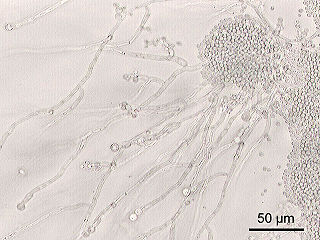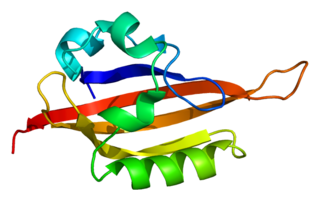
Homocysteine or Hcy: is a non-proteinogenic α-amino acid. It is a homologue of the amino acid cysteine, differing by an additional methylene bridge (-CH2-). It is biosynthesized from methionine by the removal of its terminal Cε methyl group. In the body, homocysteine can be recycled into methionine or converted into cysteine with the aid of vitamin B6, B9, and B12.

Torulaspora delbrueckii is a ubiquitous yeast species with both wild and anthropic habitats. The type strain of T. delbrueckii is CBS 1146T, equivalent to CLIB 230 or ATCC 10662, etc.. The type strain of T. delbrueckii CBS 1146 T was sequenced in 2009, and is composed of 8 chromosomes in addition to a mitochondrial genome.

Saccharomycetales belongs to the kingdom of Fungi and the division Ascomycota. It is the only order in the class Saccharomycetes. There are currently 13 families recognized as belonging to Saccharomycetales. GBIF also includes; Alloascoideaceae, Eremotheciaceae (16) Trigonopsidaceae and Wickerhamomycetaceae.

Saccharomycotina is a subdivision (subphylum) of the division (phylum) Ascomycota in the kingdom Fungi. It comprises most of the ascomycete yeasts. The members of Saccharomycotina reproduce by budding and they do not produce ascocarps.

Pichia is a genus of yeasts in the family Pichiaceae with spherical, elliptical, or oblong acuminate cells. Pichia is a teleomorph, and forms hat-shaped, hemispherical, or round ascospores during sexual reproduction. The anamorphs of some Pichia species are Candida species. The asexual reproduction is by multilateral budding.
Free fatty acid receptors (FFARs) are G-protein coupled receptors (GPRs). GPRs are a large family of receptors. They reside on their parent cells' surface membranes, bind any one of a specific set of ligands that they recognize, and thereby are activated to elicit certain types of responses in their parent cells. Humans express more than 800 different types of GPCRs. FFARs are GPCR that bind and thereby become activated by particular fatty acids. In general, these binding/activating fatty acids are straight-chain fatty acids consisting of a carboxylic acid residue, i.e., -COOH, attached to aliphatic chains, i.e. carbon atom chains of varying lengths with each carbon being bound to 1, 2 or 3 hydrogens. For example, propionic acid is a short-chain fatty acid consisting of 3 carbons (C's), CH3-CH2-COOH, and docosahexaenoic acid is a very long-chain polyunsaturated fatty acid consisting of 22 C's and six double bonds : CH3-CH2-CH1=CH1-CH2-CH1=CH1-CH2-CH1=CH1-CH2-CH1=CH1-CH2-CH1=CH1-CH2-CH1=CH1-CH2-CH2-COOH.

Endothelial PAS domain-containing protein 1 is a protein that is encoded by the EPAS1 gene in mammals. It is a type of hypoxia-inducible factor, a group of transcription factors involved in the physiological response to oxygen concentration. The gene is active under hypoxic conditions. It is also important in the development of the heart, and for maintaining the catecholamine balance required for protection of the heart. Mutation often leads to neuroendocrine tumors.

Ras GTPase-activating-like protein IQGAP2 is an enzyme that in humans is encoded by the IQGAP2 gene.
Vehicle registration plates in Luxembourg bear a maximum of six characters. The standard series in use today uses a format of two letters followed by four digits. Before adoption of the current scheme, marks consisting only of digits and two digits and three numbers letters, were issued. The digit-only plates may only now be issued as a custom plate.

Scrophularia oblongifolia, green figwort, is a perennial herbaceous plant found in Europe and Asia. It grows in damp, shady places such as wet woodland and farmland ditches. It is very similar to the closely related Scrophularia auriculata, from which it is best separated by the shape of the staminode.
Nakazawaea is a genus of yeast in the order Saccharomycetales. The relationship of this taxon to other taxa within the order is not fully unknown.
Starmera is a genus of fungi within the Saccharomycetales order. It is placed within the Phaffomycetaceae family.
Starmerella is a genus of fungi within the Saccharomycetales order. The relationship of this taxon to other taxa within the order is unknown, and it has not yet been placed with certainty into any family. Although, the GBIF list the family as Phaffomycetaceae. Several members of the Starmerella clade are associated with flowers and flower-visiting insects like bees and bumblebees; these yeasts cope well with high sugar niches. Many strains (species) of the Starmerella clade, including Starmerella bombicola and Candida apicola are known to produce sophorolipids which are carbohydrate-based, amphiphilic biosurfactants.
Dickeya is a genus of the family Pectobacteriaceae that consists mainly of pathogens from herbaceous plants. Dickeya is the result of the reclassification of 75 strains of Pectobacterium chrysanthemi, as well as Brenneria paradisiaca CFBP 4178, into a new genus. The genus is named for American phytopathologist Robert S. Dickey. Several species in this genus, such as Dickeya dadantii, are known phytopathogens.

Hanseniaspora is a genus of yeasts. The name Kloeckera is applied to its anamorph form. They are typically apiculate (lemon-shaped) in shape and often found in grape musts pre-fermentation.

Fungal DNA barcoding is the process of identifying species of the biological kingdom Fungi through the amplification and sequencing of specific DNA sequences and their comparison with sequences deposited in a DNA barcode database such as the ISHAM reference database, or the Barcode of Life Data System (BOLD). In this attempt, DNA barcoding relies on universal genes that are ideally present in all fungi with the same degree of sequence variation. The interspecific variation, i.e., the variation between species, in the chosen DNA barcode gene should exceed the intraspecific (within-species) variation.

Ogataea is a genus of ascomycetous yeasts in the family Saccharomycetaceae. It was separated from the former genus Hansenula via an examination of their 18S and 26S rRNA partial base sequencings by Yamada et al. 1994.
Wickerhamomyces is a genus of fungi within the Saccharomycetales order. It is placed within the family of Phaffomycetaceae.
Kluyveromyces dobhanskii is a species of Kluyveromyces fungus existing as a yeast.










